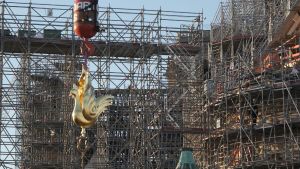Lenten Campaign 2025
This content is free of charge, as are all our articles.
Support us with a donation that is tax-deductible and enable us to continue to reach millions of readers.
On the banks of the Seine, passers-by stopped and looked up to contemplate the new ballet offered by the Notre Dame construction site. On Friday, May 24, the cathedral of Paris regained the cross on the roof over the apse. (The cross and rooster-shaped reliquary over the transept were replaced earlier.) As this cross was the only roof ornament to have miraculously escaped the devastating flames of the tragic fire of April 15, 2019, it was a particularly symbolic moment before the cathedral’s scheduled reopening on December 8, 2024.

Suspended in the air at the end of a crane, this work by Viollet-le-Duc has returned to its original position at the top of the apse of the choir roof, once again watching over the capital and its inhabitants.
From above, a clamor rises: The ironworkers and roofers who worked on its restoration turn to the journalists with a shout of victory. From below, cheers and applause respond, as if to thank the hard work of the craftsmen who have spent more than 1,000 hours restoring this two-ton cross, dented by its fall.
“Once it is on the roof, Our Lady will be invited to carry our crosses, our difficulties and our pain. This cross opens the doors to eternal life.”
A highly symbolic moment
“It’s a highly symbolic moment in the history of the cathedral’s restoration,” says Philippe Jost, head of the Public Establishment in charge of the restoration of the cathedral of Notre-Dame de Paris. “It carries a particular strength and emotion,” he continues.
It’s particular because this cross, emphasizes Msgr. Olivier Ribadeau-Dumas, rector of the cathedral, “reminds us that this edifice is not a museum,” but that it was “built for the love of God.”

A sweet smell gradually rises to the nostrils: behind a prefabricated building, placed on construction site pallets, charcoal burns in the censer. Msgr. Ribadeau-Dumas, dressed in red, approaches the cross to bless and incense it. “To bless is to speak well of: I’d like to bless this cross, by speaking well of all those who worked to make it a reality. God speaks well of this extraordinary work,” says the cathedral’s rector, before reading the Gospel according to John, “which reminds us of the meaning of the cross”:
“No one has ascended into heaven except the one who descended from heaven, the Son of Man. And just as Moses lifted up the serpent in the wilderness, so must the Son of Man be lifted up, that whoever believes in him may have eternal life. For God so loved the world that he gave his only Son, so that everyone who believes in him may not perish but may have eternal life.”
(John 3:13-16)
The cross, a symbol of love and self-giving
The cross is first and foremost an instrument of torment, a sign of suffering. However, with Christ it becomes the sign of God’s gift and love carried through to the end, as Msgr. Ribadeau-Dumas reminds us.
“Once it is on the roof, Our Lady will be invited to carry our crosses, our difficulties and our pain. This cross opens the doors to eternal life. It tells us that we are made to one day share the love of the Father and the Son in the most perfect joy.”

Killian, an ironworker at the “Fer Art Forge” workshop in Saint Aubin les Bois (Calvados), came to see the cross being placed on the roof. The young man makes no secret of his pride. “It’s a great achievement for me as a craftsman, and I’m very proud to have been able to take part in this project thanks to my profession,” he tells us enthusiastically. Already, the Notre-Dame project is taking shape: “I’m going to continue with my other projects.” Killian pauses for a moment, then smiles: “It’s going to be empty in the workshop. It was taking up a lot of space.”



